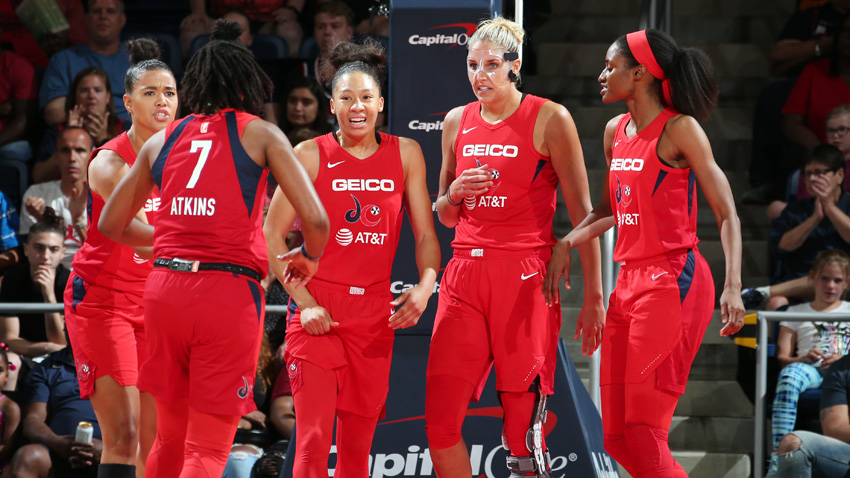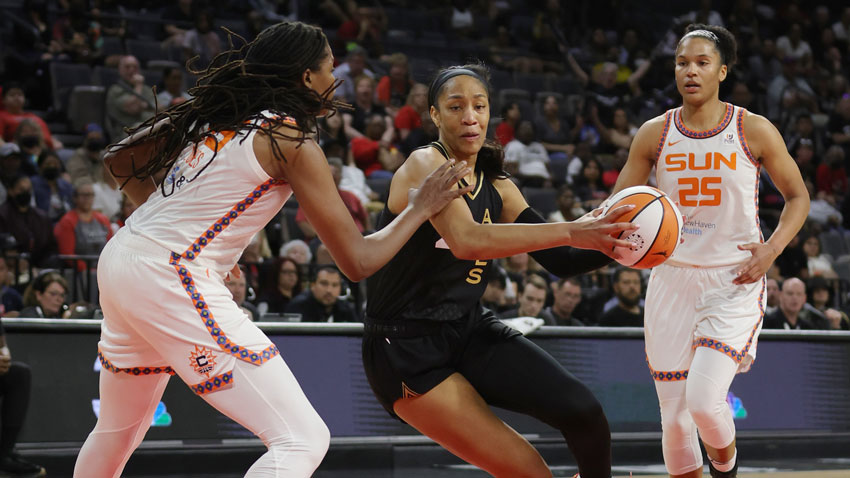Offense Soaring This Postseason

Along with the intrigue and excitement of a new playoff format, the 2016 postseason has also brought unprecedented offensive numbers in the WNBA Playoffs.
Through the first six games — the four games from the two single-elimination rounds and the first games of the best-of-five semifinals — teams are averaging more points, more assists and more free throws, and shooting higher field goal percentages, than ever before. The trend that swept across the league during the summer has extended into the fall.
| Category | 2016 | Playoff Record (Yr) |
| Points | 93.8 | 84.0 (2009) |
| Field Goal Pct. | 49.6 | 44.7 (2010) |
| Free Throws Made | 18.0 | 17.7 (2009) |
| Assists | 20.8 | 17.3 (2007 & 2010) |
| Offensive Rating | 114.2 | 102.6 (2010) |
| Effective FG Pct. | 53.7 | 49.3 (2010) |
| True Shooting Pct. | 58.3 | 54.1 (2010) |
In Chicago’s second-round win over Atlanta, the Sky set a playoff record with 37 points in the first quarter on their way to tying the existing record for most points scored in a regulation playoff game with a season-high 108. Two days later, the Minnesota Lynx broke that mark during their 113-95 win over Phoenix in the first game of their semifinal series.
Only one team in the history of the WNBA Playoffs scored more points than Minnesota’s 113 on Wednesday night. In Game 1 of the 2009 WNBA Finals, the Phoenix Mercury defeated the Indiana Fever in overtime, 120-116, in what was then the highest-scoring game in WNBA history (regular season or playoffs) and remains the top scoring game in playoff history.
One year later, the Mercury (again!) and the Lynx put on an offensive showcase in a double-overtime classic that saw Phoenix defeat Minnesota, 127-124. That game featured three 30-point scorers (Seimone Augustus 36, Candice Dupree 32, Diana Taurasi 31) and three players in the 20s (Charde Houston 21, DeWanna Bonner 20, Penny Taylor 20) and 11 total players in double figures.
In just six games, the 2016 Playoffs have produced two of the top six scoring games by individual teams and two of the top four scoring games by both teams combined in the history of the WNBA Playoffs.
Most Points Scored In A Playoff Game (Team)
| Points | Game | Date |
| 120 | Phoenix vs. Indiana | Sept. 29, 2009 (OT) |
| 116 | Indiana at Phoenix | Sept. 29, 2009 (OT) |
| 113 | Minnesota vs. Phoenix | Sept. 28, 2016 |
| 108 | Chicago vs. Atlanta | Sept. 25, 2016 |
| 108 | Detroit vs. Phoenix | Sept. 5, 2007 |
| 108 | Phoenix at Detroit | Sept. 16, 2007 |
Most Points Scored In A Playoff Game (Both Teams Combined)
| Points | Game | Date |
| 236 | Phoenix (120) vs. Indiana (116) | Sept. 29, 2009 (OT) |
| 208 | Detroit (108) vs. Phoenix (100) | Sept. 5, 2007 |
| 208 | Minnesota (113) vs. Phoenix (95) | Sept. 28, 2016 |
| 206 | Chicago (108) vs. Atlanta (98) | Sept. 25, 2016 |
| 202 | Phoenix (102) at San Antonio (100) | Aug. 30,2007 |
In this year’s playoffs, five players have reached 30 points in a single game, with Minnesota’s Maya Moore (31) and L.A.’s Candace Parker (30) hitting that threshold in Game 1 wins in their respective semifinal series. While Phoenix’s Diana Taurasi and Atlanta’s Tiffany Hayes also each had a 30-point night, the top mark of the playoffs goes to, you guessed it, Atlanta’s Angel McCoughtry, who dropped 37 points in Atlanta’s first-round win over Seattle for the seventh-highest scoring game in WNBA Playoff history. Angel now owns four of the top seven performances ever.
Most Points Scored In A Playoff Game (Player)
| Points | Player | Game | Date |
| 42 | Angel McCoughtry | ATL vs. NYL | Sept. 7, 2010 |
| 41 | Tamika Whitmore | IND at DET | Aug. 19, 2006 |
| 40 | Elena Delle Donne | CHI vs. IND | Sept. 21, 2015 |
| 40 | Maya Moore | MIN at PHX | Sept. 27, 2015 |
| 39 | Angel McCoughtry | ATL at CHI | Aug. 24, 2014 |
| 38 | Angel McCoughtry | ATL at MIN | Oct. 5, 2011 |
| 37 | Angel McCoughtry | SEA at ATL | Sept. 21, 2016 |
So what is behind this offensive explosion from the first six games of the postseason? Two key factors contributing to these soaring numbers are the pace of play and the efficiency with which teams are scoring.
Pace
During the regular season, the Dream and Sun tied for the top pace in the league — averaging 79.7 possessions per 40 minutes — about one possession more than the league average pace of 78.525.
In the playoffs, six of the eight teams in the field have played at a pace greater than 80, with the Lynx, Sky and Sparks all around 83 possessions per 40 minutes. With an average pace of 80.95, these playoff games are averaging nearly two-and-a-half more possessions per game. And more possessions translate into more opportunities to score.
Efficiency
It’s one thing to play fast; it’s another to play both fast and efficient, which is what we’ve seen early on in the playoffs.
During the regular season, the Lynx led all teams with an offensive rating of 107.2, meaning they averaged 107.2 points per 100 possessions. During their 113-95 win over Phoenix on Wednesday, the Lynx posted an offensive rating of 134.5, an incredible number that helped boost the league’s average to 114.2 through six games. But it wasn’t just the Lynx that played with incredible offensive efficiency. Every team, with the exception of the Indiana Fever, has averaged an offensive rating over 110, which is three points greater than the top mark of the regular season.
What’s the key to high offensive efficiency? Well, great shooting and taking care of the ball certainly help.
Shooting
Any way you choose to measure shooting — standard field goal percentage (49.6%), effective field goal percentage (53.7%) to add the value of the 3-point shot, or true shooting percentage (58.3%) to account for treys as well as free throws — teams have posted all-time best marks through the playoffs so far. It sure didn’t hurt to have the super-efficient MVP Nneka Ogwumike go 11-of-14 from the field, while her front line teammate Candace Parker went 11-of-15, in L.A.’s win over Chicago on Wednesday.
Turnovers
While the Sparks were plagued with turnover problems early on in that game — showing a little rust after an 11-day layoff — they were able to right the ship and cruise to a 20-point win. But even with L.A.’s 17 turnovers in that game, teams are averaging just 11.9 turnovers per game during the playoffs, which is 0.9 fewer than the 12.8 average during the regular season.
When we combine the extra possessions that teams are averaging by playing at a higher pace with the possessions they are keeping by limiting their turnovers and the off-the-charts shooting percentage, it adds up to offensive numbers that the league has never seen in the postseason.
The question is can the teams keep up this torrid pace of offensive excellence as the semifinal series go deeper and with the Finals on the horizon?
,xPosition=.5,yPosition=.5)
,xPosition=.5,yPosition=.5)
,xPosition=.5,yPosition=.5)
,xPosition=.5,yPosition=.5)